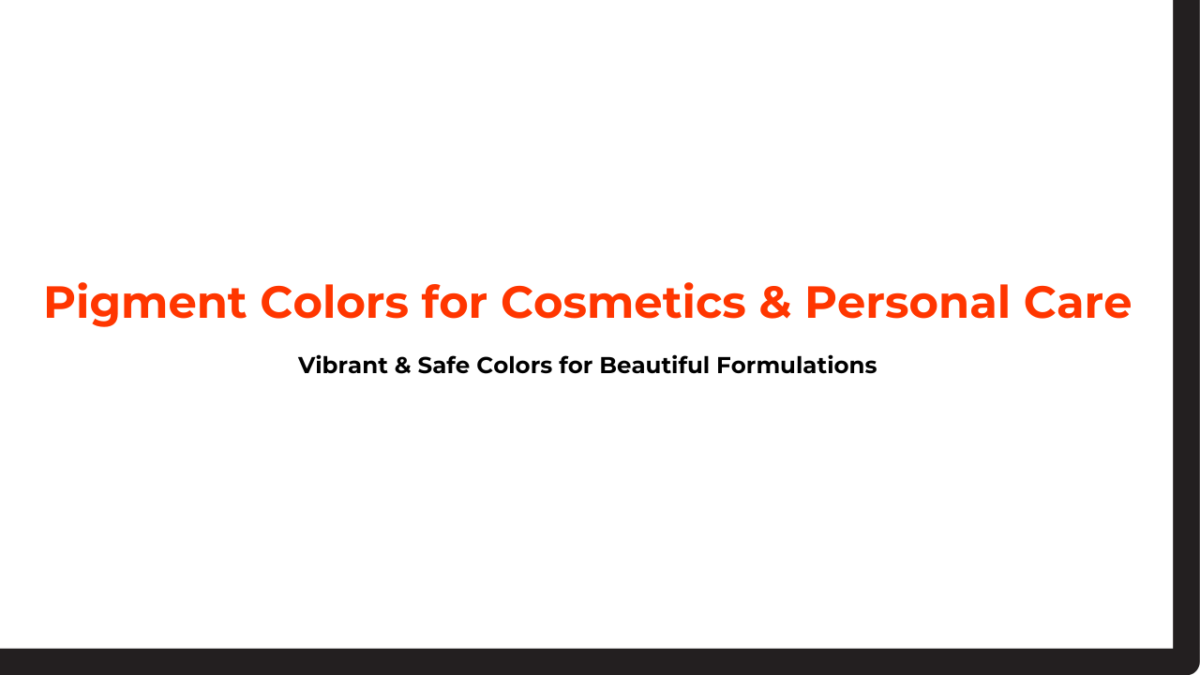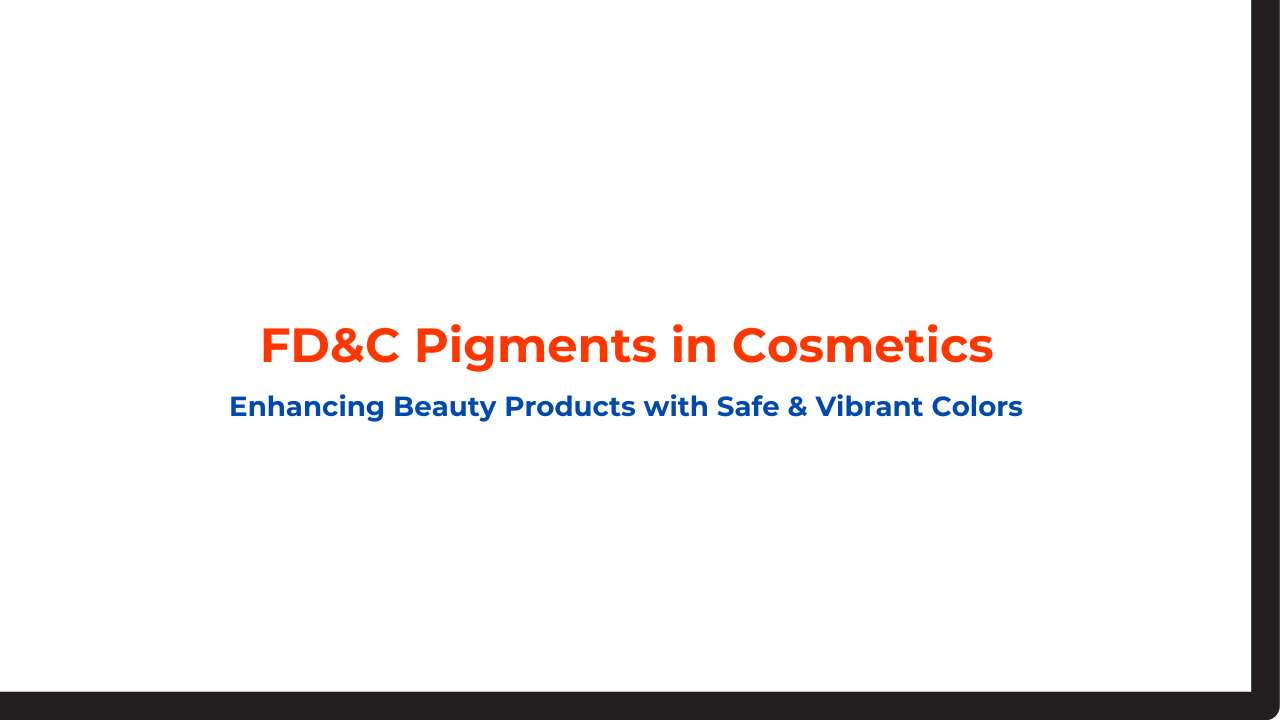Pigment colors are widely used to impart color to different cosmetic and personal care products, making them more appealing to consumers. Pigments offer vibrant hues, facets, and visual allure in numerous colored cosmetic and skin care products. This blog post will walk you through pigment colors for cosmetics and personal care products.
Pigments used for cosmetics offer a wide range of hues and shades. It is fascinating to observe how pigments have evolved over the millennia, displaying the evolution of techniques and materials used by diverse cultures to add color to the world. Using color pigments in cosmetics and skin care products can transform them from simple products into beautiful ones that captivate the senses and leave an indelible impression.
If you are a business or individual entrepreneur wondering about using pigment colors in cosmetics and personal care products, continue reading this blog.
What are Pigment Colors?
Pigment colors are colors or color additives that impart a wide range of hues, facets, and shades to make cosmetic and personal care products more appealing, beautiful, and attractive. Generally, using a pigment or pigment powder is popular for providing color or changing the visual appearance of cosmetic products more efficiently.
On the other hand, dyes are colored substances that can become soluble or dissolve in water or any other medium during their application. Both dyes and pigments differ based on their chemical properties, color stability, and solubility.
Additionally, in contrast to largely insoluble color pigments, dyes are capable of eventually entering the solution and causing a chemical reaction with water.
Types of Pigment Colors
There are various types of pigment colors, including organic, inorganic, and black pigments. Organic pigments and inorganic pigments differ greatly in how they are derived and classified for industrial applications.
- Organic Pigments
Organic pigment colors are the safest form of color pigments, and they are FDA-certified and approved for use in cosmetics and personal care products to ensure safety and product efficacy.
Furthermore, these pigment colors are widely used to color print inks and plastic products. Organic pigments are produced from natural sources, such as vegetables, plants, animals, or synthetic organic chemistry.
- Inorganic Pigments
Inorganic pigments refer to dry ground minerals, usually metals and metallic salts, that don’t rely on carbon chains and rings. This type of pigment is opaque, lightfast, inexpensive, and insoluble in water, unlike organic pigments.
Red, orange, cadmium yellow, cobalt blue, chromium oxide green, and titanium white are some synthetic inorganic pigments.
Pigment Colors for Cosmetics and Personal Care Products
The importance of color pigments in cosmetics or skin care products can’t be overstated because they provide the desired color, texture, and visual appeal to make products more appealing. The selection of color pigments depends on numerous factors, including color stability, skin compatibility, and product formulation.
In addition, cosmetic pigments are chosen based on their various properties, including color stability, safety, and compatibility with the desired application. Cosmetic manufacturers need to follow regulatory guidelines and safety standards to ensure that the obtained color pigments meet the criteria for cosmetic applications.
Types of Colours Used for Cosmetics
Organic pigments are widely used in various industries, such as paints, coatings, plastics, ceramics, and cosmetics. Pigment colors can convey various artistic ideas, both from natural sources and synthetic technologies. The use of colors spans many industries, from art and fashion to cosmetics and manufacturing.
Furthermore, it is generally known that minerals are used to make these pigments because they are stable, durable, and colorful. There are a variety of applications for some popular inorganic pigments:
- Zinc Oxide (ZnO)
Sunscreens and skincare products frequently contain zinc oxide because of its white color and UV-blocking properties. Manganese Violet (MnNH4PO4 or Mn2O3) gives cosmetics a rich violet color, specifically eyeshadow and lipstick.
- Titanium Dioxide (TiO2)
In addition to being easy to use and versatile, titanium dioxide can be bright and opacity-enhancing. The substance’s ability to reflect and scatter ultraviolet radiation makes it a popular physical sunscreen in skincare products.
What are the types of pigments used for cosmetics and personal care products?
There are various pigment types used in cosmetics, each with characteristics that can influence the color, texture, and overall performance of the product. Pigments provide vivid, vibrant colors in various cosmetic products, including lipsticks, eyeshadows, foundations, and nail polishes.
- Natural Pigments (Botanical Extracts)
Pigments produced from natural sources, such as green vegetables, trees, plants, etc., are known as natural pigments. For example, beetroot powder is used for red tones and turmeric for yellow tones.
- Synthetic Pigments
It is commonly used to create shimmering and glittering effects in eyeshadow, nail polish, and other cosmetics.
- Organic Pigments (FD&C and D&C Dyes)
Regulatory agencies are used to color skin care products, such as lipsticks, eyeliners, and other cosmetics.
- Inorganic Pigments (Iron Oxides and Titanium Dioxide)
Iron oxides are widely used to create earthy tones, including reds, browns, and yellows in foundations, blushes, eyeshadows, and lipsticks. Titanium Dioxide is a white pigment used for opacity in sunscreens and foundations, providing lighter shades and contributing to UV protection.
- Pearlescent and Special Effect Pigments (Mica)
Natural pigments from this mineral provide shimmer in eyeshadows, highlighters, and nail polishes.
Pigment Dispersion for Cosmetics & Personal Care
Finding natural pigments from plant sources that align with the demand for natural and clean cosmetics is essential. Furthermore, it is pigment dispersions that help businesses create vibrant and diverse color palettes that can be found in all kinds of cosmetics and personal care products.
There are a variety of reasons why pigment dispersions are necessary in the cosmetics and personal care industry. They contribute to product quality, consistency, and performance. Here are some reasons that clearly explain the importance of pigment dispersions in cosmetics and personal care production:
- Seamless Incorporation into Different Formulations
Water-based dispersions, oil-based dispersions, and emulsions allow for versatile formulations for cosmetics and personal care products.
- Consistent Texture and Application
When the dispersion is good, the product’s application becomes more comfortable, resulting in a smooth and consistent texture.
- Uniform Color Distribution
This ensures uniform color distribution, preventing clumps, and ensures consistency of look when applied.
Conclusion
The bottom line is that pigment colors used for cosmetic and personal care products are essential in making products more beautiful, appealing, and valuable.
Many companies are using pigment colors, pigment dyes, and organic dyes or pigments to enhance the visual appearance of their cosmetic and personal care products and make them more appealing and interesting to consumers.
If you are a cosmetic manufacturer looking for premium quality cosmetic pigments or dyes for your industrial applications, look no further than Hridhan Chem Pvt Ltd. Hridhan Chem is a reputable manufacturer and exporter of high-quality synthetic dyes and pigments used for cosmetics, foods, pharmaceuticals, and other applications.
Contact us today for more information on the wide range of cosmetic dyes and pigments we produce!




